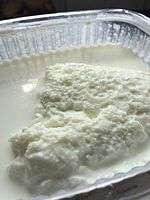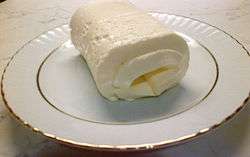Kaymak
|
Kaymak from Turkey | |
| Course | Breakfast and dessert |
|---|---|
| Place of origin | Turkic Central Asia |
| Region or state | Azerbaijan, Turkey, Macedonia, Serbia, Montenegro, Bosnia and Herzegovina, Iraq, Iran, Afghanistan |
| Main ingredients | Milk |
| Variations | Kaymar, Gaymar, Qaimar |
|
| |
Kaymak is a creamy dairy product similar to clotted cream, made from the milk of water buffalos, cows, sheep, or goats in Central Asia, some Balkan countries, Turkic regions, Iran and Iraq.
The traditional method of making kaymak is to boil the milk slowly, then simmer it for two hours over a very low heat. After the heat source is shut off, the cream is skimmed and left to chill (and mildly ferment) for several hours or days. Kaymak has a high percentage of milk fat, typically about 60%. It has a thick, creamy consistency (not entirely compact due to milk protein fibers) and a rich taste.
Etymology
The word kaymak has Central Asian Turkic origins, possibly formed from the verb kaymak, which means melt and molding of metal in Turkic.[1] The first written records of the word kaymak is in the well-known book of Mahmud al-Kashgari, Kutadgu Bilig.[1] The word remains as kaylgmak in Mongolian, and with small variations in Turkic languages as qaymaq in Azerbaijani,[2] qaymoq in Uzbek,[3] каймак in Kazakh, Kyrgyz,[4] kaymak in Turkish and Turkmen[1] and καϊμάκι (kaïmáki) in Greek.
Turkey
Shops in Turkey have been devoted to kaymak production and consumption for centuries. Kaymak is mainly consumed today for breakfast along with the traditional Turkish breakfast. One type of kaymak is found in the Afyonkarahisar region where the water buffalo are fed from the residue of poppy seeds pressed for oil. Kaymak can also describe the creamy foam in the traditional "black" Turkish coffee. Kaymak is traditionally eaten with baklava and other Turkish desserts, fruit preserve and honey or as a filling in pancakes.
Balkans
.jpg)
Known as kajmak, it is almost always produced in the traditional way, in private households; commercial production is also gaining in popularity, but the best kajmak is sold at markets in some countries on the Balkans. The most expensive kajmak is the freshest one which is only a day or two old. It can keep for weeks in the fridge but it becomes hardened and not as tasty as the fresh kajmak.[5] Kajmak can also be matured in dried animal skin sacks, and this variation is called skorup. Kajmak can also describe the creamy foam in the traditional "black" Turkish coffee in the Balkans.
It is usually enjoyed as an appetizer, but also as a condiment. The simplest recipe is lepinja sa kajmakom (bun bread filled with kaymak in Serbia) consumed for breakfast or as fast food. Bosnians, Montenegrins, Serbs, and Macedonians consider it a national meal. Other traditional (sold in restaurants) dishes with kajmak include pljeskavica sa kajmakom (the Balkan version of a hamburger patty topped with melted kajmak), as well as ribić u kajmaku (beef shank, simmered with kajmak).
Iraq

In Iraq, it is called Gaimar or Qaimar and is very popular. Possibly derived from the ancient Sumerian word "Gamur" or Ga'ar which means cheese.[6] Gaimar is usually served for breakfast with fresh bread, honey or jam and hot tea. Two sources to buy Gaimar in Iraq, factory produced or local vendors (farmers) who are commonly named Arab, Arbans or Madan and thus its referred to as Gaimar Arab or Gaimar Maadan as of farmers Gaimar. It is usually made from the milk of water buffalos which are prevalent in the marshes of Southern Iraq. Another Iraqi dish usually served with Kaimar is Kahi, a type of Iraqi pastry popular in Baghdad. Iraqi Jews of Southern Iraq traditionally serve Gaimar on a kahi bread and flavor it with date honey during Shavuot.
Iran
In Iran, the words kaymak (Qaymaq) and Sarshir are both used to name this type of cream.
See also
References
- 1 2 3 "kaymak".
- ↑ az:Qaymaq
- ↑ http://www.kurgun.com/sozlukler/index.php?a=srch&d=22&id_srch=7dee460f83863ee737c735e21067b92c&il=tr&p=1
- ↑ [email protected]. "KIRGIZCA - TÜRKÇE - RUSÇA SÖZLÜKLER".
- ↑ Nikola Vrzić (December 28, 2000). "Sve srpske kašike" (Windows-1250). NIN (in Serbian). Retrieved 13 June 2012.
- ↑ "ePSD: ga'ar[cheese]".
- The Poppy Growers of İsmailköy (2002)
- Davidson, Alan. Oxford Companion to Food (1999). "Kaymak", pp. 428–429. ISBN 0-19-211579-0
- travelserbia.info
External links
![]() Media related to Kaymak at Wikimedia Commons
Media related to Kaymak at Wikimedia Commons

